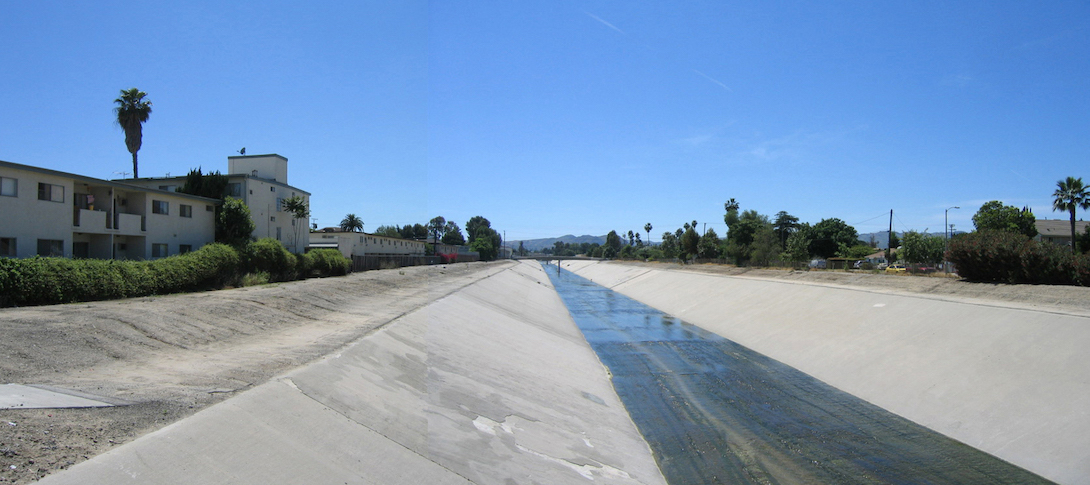Waterways have the potential to make cities more sustainable and joyful – but, as we’ve seen in LA, it requires collaboration, creativity and community

Words by Mia Lehrer
Waterways give life to and shape cities across the globe. For lucky urban denizens, their rivers and canals protect them from storm surges, offer access to nature, and function as shared sites of recreation, production, connection – and joy. This isn’t always the case. In cities such as Los Angeles, waterways take the form of hostile concrete landscapes that offer little in the way of community space, flood protection or nature. What does it take to reshape this type of urban river into an asset that everyone can enjoy?
There is growing global interest in addressing the question, from LA, Atlanta and the Bronx in the United States to Mexico City and Kuala Lumpur. The technical capacity and design expertise exists. We can help rivers do more to control floods and preserve ecology at the same time. We can use new, more porous and less carbon-intensive materials that are better for people and mitigate climate change. In these environments, the pleasure of seeing wildlife and native flora return is a remarkable experience. As landscape architects, urbanists and advocates, this is some of our practice’s favourite work. But it doesn’t happen overnight, and good design isn’t enough on its own.
These projects require a deep, long-term commitment. The frequent need to operate at a regional scale adds time and complexity. Studio-MLA has been engaged in helping to revitalise the Los Angeles River – a 52-mile (84km), concrete-lined channel – for more than 25 years, and the effort is by no means over. Design and project teams need to stay dedicated and connect with the community groups, non-profits, and public agencies that are invested in recalibrating urban rivers. The expertise and knowledge of designers, planners and engineers can help these groups more effectively advocate for change – and vice versa. As is so often the case, we are stronger together.
 Existing stretch of the LA River
Existing stretch of the LA River
And yet it is also crucial to help identify and support strong project champions. Whether public officials or citizen advocates, the most successful revitalisation efforts benefit from devoted leaders who can exert pressure and marshal broad support – and funding. A great example is the late Lewis MacAdams, who founded the non-profit Friends of the Los Angeles River in 1986 and catalysed its ongoing transformation through decades of tireless activism. Much of the work that firms such as Studio-MLA, Tetra Tech and others have done around this urban river arose from MacAdams’ advocacy.
When it comes to shaping the vision of waterway transformation, the plans need to build equity into the framework from the very beginning. This is an arena where the skills and expertise of designers can have a clear impact. Project teams can combine public workshops and grassroots engagement with geodesign principles to understand a region’s demographics, community health, pollution levels, water quality, flood risk, geography, ecology and cultural values, and open-space needs. This will help establish equity priorities and pinpoint areas where large impacts can be avoided – and where urban quality of life can be dramatically enhanced.
 Studio-MLA vision of the same stretch
Studio-MLA vision of the same stretch
Using this process model for the Upper Los Angeles River, our project team ultimately identified more than 700 opportunities for improvement throughout some of California’s most disadvantaged communities. The result will be restored natural habitats, connections to park-poor neighbourhoods with public greenways, and improvements to the river’s flood capacity and water quality. Simply put, the ultimate outcome of this equity-based framework is a better urban environment for everyone.
Engaging in these efforts is some of the hardest work that designers can do. But it is hugely rewarding for anyone who believes in the power of making change. And of course, the built outcome is worth the effort. There may be no better feeling than seeing that first hawk resting on a tree limb on a riverfront where no trees stood just a few years before.
It is also important to recognise that an urban river is as much about the future as it is about the pleasure of the present. The collective repair of the earth is a constant endeavour, but by reshaping these spaces for recreation, community and ecology, design teams will ultimately contribute to the enhanced experience and continued vitality of people, cities, and nature for decades – and hopefully centuries – to come.
Mia Lehrer FASLA is a landscape architect, urbanist and founder of Studio-MLA, a landscape architecture firm based in Los Angeles and San Francisco
This article was featured in ICON’s Autumn 2021 issue. Read the digital edition for free
















